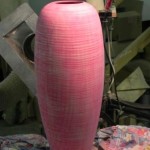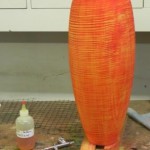In an earlier post I discussed the construction of the tools I needed for turning large hollowforms. I had roughed out the form prior to drying which was to be the next step in the process. I feared the piece might crack. Much to my dismay, the drying process initialized a crack at the opening as well as some small cracks on the bottom. The top crack would affect the appearance while the bottom cracks were minute and were to be turned away in the finishing process.
To say the least, I was upset. I was able to halt the cracking with CA glue, then watching it a couple of times a day while the piece continued to dry. Finally it had lost enough water that the weight stabalized and was ready to finish turn; about three months, as I had anticipated.
During that time I thought of various ways in which to turn this disaster into a “design opportunity”. Originally, I had planned on making a cap to close in the opening much like “Black on Black” and “Blue Planet” (see gallery). Continuing on that idea, I envisioned wings or leaves eminating from the cap and finally settled on the design in the photograph, encorporating a bit of texturing to add some interest and contrast with the gloss finish. The shape of the cap also corrected the line of the form that had turned too sharply at the top when turning much of the crack away. In the end I actually felt that the final product was more dramatic than the original concept. To say the least, I was very happy with “the save”.
The original blank weighed 40 lbs. After initial turning it weighed 10 lbs. After drying (loosing about 5 lbs. of water) and finish turning, the piece weighed 4 lbs. – 10 percent of its original weight.
The customer specified a reddy orange/yellow colour combination that I had applied to a Zen Candle that she had purchased earlier. After bleaching the piece twice I applied a red dye which was then sanded back, exposing new wood. Yellow was applied to achieve the final result. If you notice there is an airbrush in the photos. I have had issues with colour contamination in my applicators and dye containers. Using an airbrush eliminates contact with applicators that pick up the original colour from the work. The cap was painted black and textured after turning and carving to shape. Both were finished with (I forget how) many coats of Wipe On Poly.
On a sad note, the remainder of the wood that I bought for the piece cracked severely. There is enough to make two more pieces the same size so that is quite a loss, however I have another “save” in mind that may make them equally as spectacular. Here’s hoping!
As always, I encourage your comments and questions, so please refer to the tag line at the bottom of the article to post a comment.






5 Responses to Supersized hollowform completed